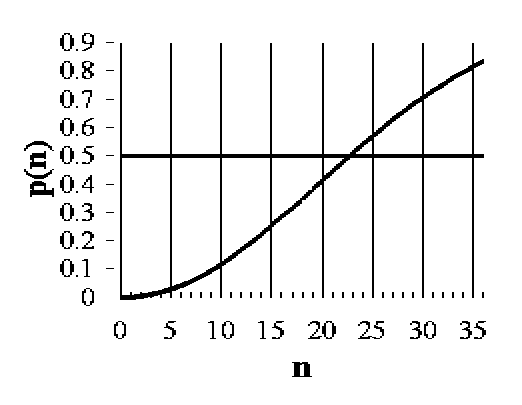 f
course, you recognized at once that the wager is an elementary
exercise in probability theory, and you remembered the
solution: That, given as few as 23 persons selected at
random, there is a better than an even chance that at
least two of them have the same birthday {HyperNote}. f
course, you recognized at once that the wager is an elementary
exercise in probability theory, and you remembered the
solution: That, given as few as 23 persons selected at
random, there is a better than an even chance that at
least two of them have the same birthday {HyperNote}.
Both you and the statistician were able
to count only 20 persons, so it was not an even bet.
Based on numbers, you would likely lose -- a situation
made decidedly worse by the evidence of a birthday
being celebrated at the nearby table, unless...,
unless...
You would expect that, even while losing
her own bet, your friend might have wished you a happy
birthday.
HyperNote
 he solution is traditionally found by first
reversing the statement of the problem: he solution is traditionally found by first
reversing the statement of the problem:
Instead of asking...
Selecting at random, how many people are
needed to assure an even bet that at least two of them
share the same birthday?
...the sophisticated solver asks...
Selecting at random, how many people are
needed to assure an even bet that no two of them share
the same birthday?
For convenience, let's let...
n = the unknown number of
persons,
p = the probability that two or more
persons share the same birthday, and
q = the probability that no two persons
share the same birthday.
You seek the minimim value for n such that
p > 1/2. You know that p = 1 - q, and you can easily
find the value of q for two extreme values of n...
If n = 1, then q = 1 and p = 0 --
impossible: no other person with whom to share a
birthday.
If n = 365, then q = 0 and p = 1 --
certainty: no more birthdays to spread around without
duplicates.
For every value of n, there are 365n
possible combinations of birthdays, which is absolutely
all there can be. Accordingly, that is what goes into
the denominator of the fraction used to calculate your
probability q. Your numerator requires only slightly
more sophistication in numbers.
Any person you might select at random
will have one of 365 birthdays. That leaves only 364
birthdays for the second person, in order to satisfy
the part of the conditions mandated by probability q
which says "no two of them share the same birthday."
Having given one of those birthdays to the second
person, you will have only 363 birthdays for the third
person. And so forth.
You can make a table and a graph as
follows:
|
n
|
q
|
p
|
|
1
|
(365)
(365)
|
0
|
|
2
|
(365)(364)
(365)(365)
|
0.00274
|
|
3
|
(365)(364)(363)
(365)(365)(365)
|
0.00820
|
|
4
|
(365)(364)(363)(362)
(365)(365)(365)(365)
|
0.01636
|
|
...
|
and so forth
|
...
|
| 23
|
Hoo-ha!
|
0.507297
|

|